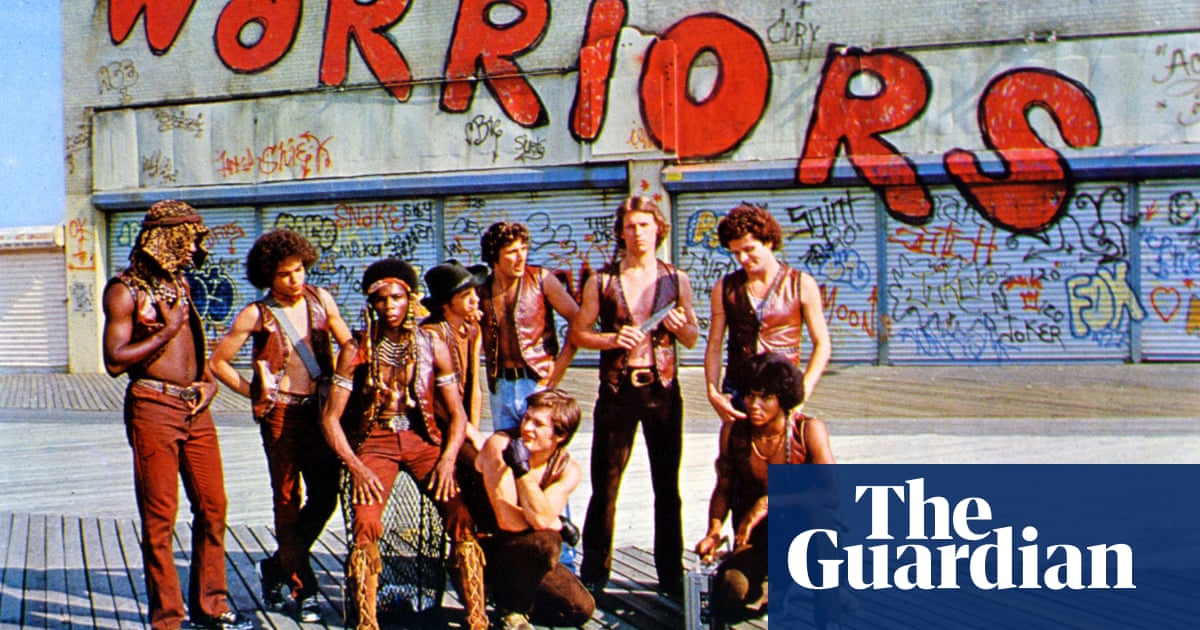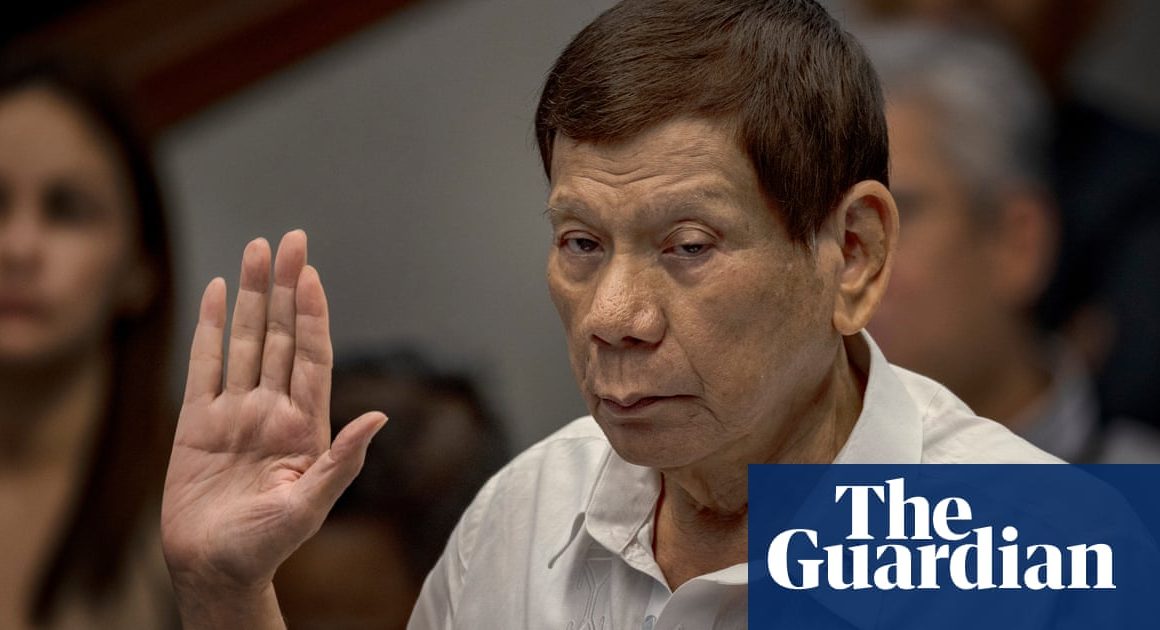What is the most cherished movie from your early childhood? Probably not The Warriors, Walter Hill’s fierce thriller about New York gang battles. But as Lin-Manuel Miranda says with a grin: “Our friend’s older brother had the VHS …” Which is how four-year-old Miranda found himself watching the film that, 40 years later, the Hamilton composer has turned into a musical concept album with playwright Eisa Davis.
He describes the nefarious mood in the room as the video played. “Here’s something you’re not supposed to be seeing. But let’s watch it. This is what New York is really like at night.” The cult 1979 film follows a Coney Island clan on a hair-raising journey home from the Bronx after being falsely accused of killing the leader of the city’s biggest gang. They encounter “every fear you’re supposed to have as a New Yorker” says Miranda. “Falling into the train tracks. The wrong cop on the wrong night. Stepping into the wrong neighbourhood at the wrong time when some shit that has nothing to do with you pops off.”
The film is propelled by a rock soundtrack with suspenseful synths, as well as songs like Nowhere to Run – played “for all you boppers out there” by an enigmatic DJ. It was adapted from Sol Yurick’s 1965 novel (itself inspired by Xenophon’s ancient epic Anabasis, about a Greek army’s homeward odyssey) and Yurick referenced rock’n’roll, the Beatles and pachanga music throughout his tale.
The album was created in the same mould as Jesus Christ Superstar and the Who’s Tommy, which were both released as LPs before becoming stage musicals. The former was “a north star for us”, says Miranda. “You listen and you create the story in your head. The sounds are so specific to the characters. Mary Magdalene is in 5/4 and sounds like the dreamiest folk song you ever heard, and then King Herod is like a burlesque. You’ve got this rock Jesus. And Judas gets all the funkiest bass lines.”
Davis and Miranda compiled playlists evoking what a Warriors musical might sound like. When I ask what songs they chose, they each reach for their phone. We are on a three-way Zoom call and the elegantly dressed Davis’s minimal decor is a contrast to the cluttered shelves behind Miranda, whose baseball cap quotes Hamlet (“words, words, words”). They fire off their initial ideas: Roy Ayers, the Strokes, Cardi B, Rubén Blades, Beyoncé’s All Night. “Ms Lauryn Hill is on there with Ready or Not,” says Davis. Hill was one of their coups when casting the roles, and this is where the concept album format trumped a stage production: “We invited all these incredible artists we would never have got for eight shows a week,” Davis explains. “So we got to have Marc Anthony and Shenseea and Kim Dracula and all our legendary MCs on the opening number.”
The album begins with the thunderous Survive the Night, with dancehall star Shenseea as a DJ introducing New York’s five boroughs, each represented by top rappers. “To write verses for some of the greatest writers we have is very, very, very, very, very [put five “very”s, he insists] intimidating,” admits Miranda. With Staten Island, there was “no Plan B”, he says. It had to be RZA and Ghostface Killah from Wu-Tang Clan, who nicknamed their home borough Shaolin, and even referenced The Warriors on their debut album.
The album is executive-produced by Nas, who is from Queens. “This is Nas’s favourite movie, too,” says Miranda. The pair had been discussing a different project when Miranda mentioned what he and Davis were up to, “and his eyes popped out of his head!” Miranda felt the pressure: “Do I have a Queens metaphor he hasn’t tried in his long and amazing career?” He came up with a Queen’s gambit chess metaphor, then “played him his verse, me doing the vocal and him listening to what I’m asking him to recite”. Nas gave the nod. “That’s one of my proudest lyricist moments!”
In his novel, Yurick’s all-male, “fight-ready” Coney Island gang the Dominators (renamed the Warriors in the film) form both family and army, their exaggerated machismo leading to an actual pissing contest. The film, released amid a wave of other gang movies including The Wanderers and The Outsiders (which is now a hit Broadway musical), went halfway to making the gang sympathetic – and omitted a gang-rape scene that is in the novel.
Miranda’s chief change was to make all the Warriors female, a decision inspired by the Gamergate incident in 2014, which he sums up as “terminally online dudes doxing women who dared to like video games”. That misogynistic behaviour reminded Miranda of the “malignant chaos” in the film that’s caused by Luther shooting Cyrus, the city’s almighty gang leader who was proposing a truce among the tribes; Luther then blames the Warriors. Miranda and Davis’s gang share a sisterly solidarity as they essentially reclaim the night. Cyrus is now female too, played by Lauryn Hill.
The film is less brutal than the novel but became embroiled in controversy after outbreaks of violence were linked to screenings in 1979. The Washington Post observed it was “difficult to shake the feeling that the movie is socially irresponsible in some respect”. Davis had never seen the film when Miranda asked her to collaborate; what she responded to most was Cyrus’s truce proposal at the beginning, which is then swept away as the action cranks up. “There was a real-life meeting of all the gangs in 1971 in the Bronx, led by Benjy Melendez of the Ghetto Brothers. And another famous gang truce in 1992 after the uprising in LA,” she says. “So there’s something very real about that moment, with Cyrus saying, ‘Can you dig it?’ I was like, ‘I can dig it!’”
Davis – whose plays include Angela’s Mixtape, which featured her aunt, the political activist Angela Davis, as a character – turned the truce into a dream of peace threaded throughout the album. The 1971 meeting, she points out, helped form “the cultural conditions that created hip-hop officially in 1973. There was a shift from being a gang that’s at war with other gangs to being a crew that is going to battle other crews as MCs, as great dancers, as graffiti writers, as DJs.” She sees the album as a “love letter to the origins of hip-hop”.
Collaborating with Davis gave Miranda a welcome contrast to Hamilton, “which I largely wrote alone, sweating, chronologically”. Working with Encanto’s soundtrack producer Mike Elizondo, they identified genres including ska, punk and R&B for each gang’s lyrics – and found a way to represent the Furies, who never speak. The skinhead Turnbull ACs from the Bronx are given a salsa sound. “While the Warriors were running, [record label] Fania was revolutionising salsa music all over the world. And those artists primarily lived in northern Manhattan and the south Bronx.”
There are several former Hamilton stars playing the Warriors, including Phillipa Soo, who was invited to record the demos. “It was all very secret,” she tells me. “And like a family reunion.” Hamilton alumni Sasha Hutchings and Jasmine Cephas Jones were there, as was Amber Gray whom Soo met on her first professional gig after drama school. Their shared history helped establish the bond between the seven-strong Warriors and their new recruit, Mercy, portrayed by Julia Harriman who, like Soo, had played Eliza in Hamilton opposite Miranda. Delineating so many different gang members was one of the main challenges. “Really great writers,” says Soo, “are able to encompass an idea, an important plot point or a character trait in a very short amount of time”.
In the movie, Luther was played by musical theatre star David Patrick Kelly, who based his portrayal on the New York Dolls after meeting them while working at the famous nightclub Max’s Kansas City. Kelly has a cameo on the album, playing a cop. Miranda tried to write rap verses for Luther “but the thinking was too ordered”. He sought a more chaotic energy. Davis suggested they use a metal singer, and Atlantic Records led them to the operatic growl of Tasmania’s Kim Dracula.
“I think everyone who listens to it goes, ‘What the fuck was that?’” laughs Miranda. Luther’s demonic number Going Down likens the stations on a New York transport map to dots in a Pac Man game, with him as a ghost hunting the Warriors down. (When Davis first watched The Warriors, she told Miranda: “This should be a video game.” As a superfan he was a step ahead. “It is,” he replied. “I play it!”)
The Warriors has such a cult following that there is even a marathon run by fans, tracing the gang’s route through the city. Miranda and Davis made their own way to the parks, subway stations and streets featured in the film – but took a daytime jaunt rather than an overnight trek.
“We made it all the way to Coney by sunset,” says Davis, who grew up in Berkeley, California: “I truly romanticised New York as a kid. This is the place where you go, like in the movie Fame, and dance on taxicabs.” Miranda was born in New York a year after the film came out. He recalls a golden age of 70s films made on location there, including Dog Day Afternoon and The French Connection. “If you want the love and peace flipside to The Warriors, watch Godspell – you see hippies singing about Jesus in the same places the Warriors were fighting.”
In the film, each gang has a signature outfit, from the baseball uniforms of the Furies to the Warriors’ leather vests worn over bare chests. When Miranda screened it at his film club, he put on the vest: “I had to go on a weeklong diet!” The big question is: will Miranda and Davis’s Warriors get all dressed up and hit the stage? Miranda thinks back to when Hamilton tickets were gold dust. With the album of The Warriors, he says, “you’re not getting the soundtrack to a show you can’t see. You are getting the thing we made. That feels enormously gratifying.” But he admits a theatrical version would be “enormous fun”, and they are open to the idea. All you boppers out there: The Warriors’ journey surely won’t end here.











